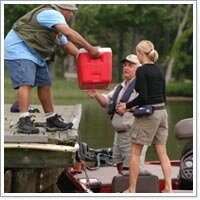It’s an indisputable fact of life that things on a boat break—as the sun’s going down, and the crew is looking to you to heal your broken boat and get them back to shore safely.
Familiarity
Boat engines are so much more reliable than in the past—with regular maintenance they should last for decades. Just because you’ve never had a problem with your boat’s engine is no excuse for complacency.
You owe it to yourself to become familiar with your boat’s propulsion system (outboard, stern drive engine/stern drive unit, inboard engine/inboard transmission) not only for the sake of gaining knowledge or conducting routine service, but so you can perform emergency on-water repairs if necessary.
Learning
We realize that the prospect of working on your boat may be a bit intimidating—we’ve been in your shoes and we understand.
That’s why we recommend that you invest in a service manual for your boat’s engine, as well as some of the excellent do-it-yourself materials (books, CDs, DVDs, on-line) available at your local marine dealer, library, or on the internet.
Spares
Carrying spare parts on your boat (and knowing how to install them) can prevent an afternoon’s cruise from turning into an all-night misadventure. Exactly which spare parts really depends on what kind of engine your boat has, and where you’re planning to go boating.
For example, a two-cylinder outboard motor won’t need as many spares as a V-8 inboard; the little outboard is a simple engine and has fewer components to fail than the larger engine does.
And if you boat on a lake so small you could throw a baseball to someone on shore, your situation probably won’t require the same spare parts as the saltwater angler who ventures miles offshore. On the pond, help can be easier to get than on the high seas.
Without knowing your situation, we can’t give you an itemized list of what spare parts you may need—however, these are some of the most common replacement parts:
- Belts—for the alternator, water pump, etc
- Hoses and hose clamps
- Spark plugs
- Fuel filter(s)
- Oil—two-stroke oil or four-stroke motor oil, depending on your engine
- Fuel line
- Transmission fluid—inboard boats
- Coolant
- Light bulbs (for each different light on your boat)
Make sure to write down your engine’s serial number before you go shopping for parts. On outboards, the serial number is usually on the clamp bracket (the part that holds the outboard on the boat); on inboards and stern drive boats, you can probably find the serial number on a decal located on top of the engine.
Tools
To ensure that you always have tools on board, we recommend putting together a tool kit that stays on the boat. Your boating tool kit should contain at least:
- Vise-Grip® pliers
- Adjustable wrench
- Utility knife
- Spark plug wrench
- Propeller wrench (or a ratchet and socket that’ll fit the propeller nut)
- Flashlight w/good batteries
- Fuses (assorted)
- Short length (a foot or two) of 14 gage/medium-sized insulated wire
- Electrician’s tape
- Duct tape
- Tie straps
Remember…
…that if your boat breaks down, you can’t walk home—so be prepared.
